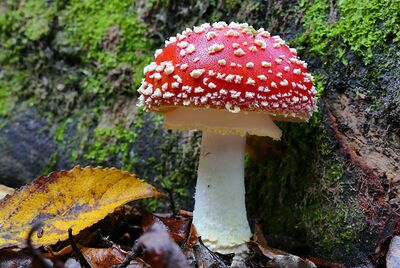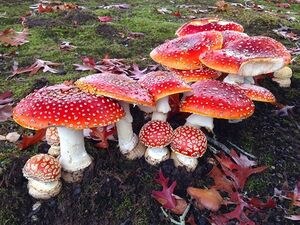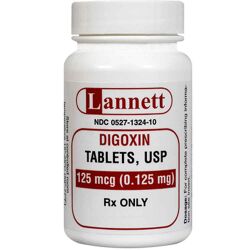Amanita muscaria

Amanita muscaria, also known as fly agarlic, is a basidiomycete fungus native to temperate and boreal regions in the Norther Hemisphere.
Taxonomy
| Kingdom | Phylum | Class | Order | Family | |
|---|---|---|---|---|---|
| Classification | Fungi | Basidiomycota | Agaricomycetes | Agaricales | Amanitaceae |
Overview

Digitalis purpurea are perennial herbaceous flowers and posses course, lanceolate leaves with rounded teeth on the margins. The leaves are alternately positioned on the stem of the common foxglove, can grow up to a foot long, and are covered in gray-white hairs. In its first year of growth, Digitalis purpurea forms a tight rosette of leaves before forming the upright flower stem, standing 3-4 feet tall, in the second year of growth. Digitalis purpurea most commonly forms 20-80 flowers on one side of the stem however, through cultivation, flowers can be produces completely surrounding the stem. Digitalis purpurea blooms in early summer and is a common garden flower, being selected for its color ranging from purple to pink and white, as well as flower position and height. [2]
Ecology
Digitalis purpurea grows in full light to partial shade. The flower will grow in many types of soils, however, it thrives in light, moist soils high in organic matter. A ring of nectar at the base of the flower tube is pollinated by a variety of bees as well as humming birds. Foxglove is protandrous, with the bottom most flowers being female and flowers 3-7 being male. Bees predominately visit female flowers first, fertilizing them with pollin from another plant, and can also promote out-crossing if pollinator remain on the plant long enough to remove pollen from a male flower, increasing the probability of pollen transfer.[3] Once pollinated, these flowers form rounded fruit capsules which split at maturity to release small brown seeds for future germination. [2] Soil Salinity has a negative affect on Digitalis purpurea overall growth and protein content with increasing concentrations of NaCl, however, root growth has been shown to increase with soil salinity.[9]

Medicinal Use

All parts of the Digitalis purpurea plant are toxic for humans to consume, however, this species has been revolutionary in cardiac and anti-cancer medicine. Cardiotonic glycosides are compounds extracted from the leaves of Digitalis purpurea and are used in Digoxin, a common medication used to treat congestive heart failure and atrial fibrillation.[6] Bio accumulation of cardiotonic glycosides can be affected by climate and soil conditions, current medicinal forms of this compound are produced through artificial cultivation to mitigate these factors.[4] Foxglove has been used to treat ailments of the heart for the past 200 years, however, Digoxin, a cardiac glycoside, was first isolated from the Digitalis purpurea plant in 1930 by Dr. Sydney Smith.[7][8] Although foxglove has been used in cardiac medicine for centuries, recent research shows the possibility for digitalis compounds to be used in oncology for their anti-tumorous properties. Heywoodii an extract from the leaves of Digitalis purpurea, has been shown to have cytotoxic activity against three human cancer cell lines. Evaluation of methanolic extracts have shown an apoptotic effect, and may be used to treat certain forms of cancer in future oncological practice.[5]
References
1. "Digitalis purpurea - Plant Finder". www.missouribotanicalgarden.org. Retrieved 2023-03-30.
2. "Common foxglove, Digitalis purpurea". https://hort.extension.wisc.edu/articles/common-foxglove-digitalis-purpurea/. Retrieved 2023-03-30.
3. Best, L. S., & Bierzychudek, P. (1982). Pollinator Foraging on Foxglove (Digitalis purpurea): A Test of a New Model. Evolution, 36(1), 70–79. https://doi.org/10.2307/2407968
4. Pérez-Alonso, N., Wilken, D., Gerth, A. et al. Cardiotonic glycosides from biomass of Digitalis purpurea L. cultured in temporary immersion systems. Plant Cell Tiss Organ Cult 99, 151–156 (2009). https://doi.org/10.1007/s11240-009-9587-x
5. López-Lázaro, Miguel; de la Peña, Nieves Palma; Pastor, Nuria; Martín-Cordero, Carmen; Navarro, Eduardo; Cortés, Felipe; Ayuso, María Jesús; Toro, María Victoria. (2003). Anti-Tumour Activity of Digitalis purpurea L. subsp. heywoodii. Planta Medica, https://doi.org/10.1055/s-2003-42789
6. Yukari Ikeda, Youichi Fujii, Ikuko Nakaya, and Mitsuru Yamazaki. (1995). Journal of Natural Products58 (6), 897-901 DOI: 10.1021/np50120a012
7. "Digoxin - British Heart Foundation" https://www.bhf.org.uk/informationsupport/heart-matters-magazine/medical/drug-cabinet/digoxin. Retrieved 2023-03-30.
8. "Digoxin - The American Society of Health-System Pharmacists". https://www.drugs.com/monograph/digoxin.html. Retrieved 2023-03-30.
9. Morales, C., Cusido, R. M., Palazon, J., Bonfill, M. Response of Digitalis purpurea plants to temporary salinity. Journal of Plant Nutrition, (1993). https://doi.org/10.1080/01904169309364532.